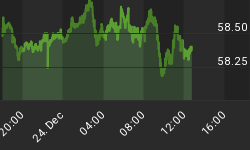In order to find a correlation between economic activity - which eventually feeds into lower or higher commodity prices - and interest rates it is very important to understand how the basic process for financing economic activity works. Banks borrow money from Central Banks and money savers at a low rate (=the FED Fund) and lend it at a higher rate to their customers. The difference between these two rates (=the interest spread) is the margin banks can earn money from lending money. The higher the spread, the more attractive is it for banks to lend money . For this reason, a high interest spread leads to higher economic activity and therefore also to higher gold and commodity prices.

In the above chart, the interest spread is - for the sake of simplicity - the difference between the FED Funds and the 10 year Treasury bond. Very clearly it can be seen that a high interest spread is a leading indicator for economic activity i.e. US production. The interest spread is for this reason a very important part for any leading indicators published by the financial press.

The interest spread is directly influenced by Central Banks through lowering and increasing the base lending rate (see above chart). Higher FED Funds lower the spread as then the difference towards the market interest rates shrinks.
A smaller interest spread then diminishes the attractiveness of lending money for banks and economic activity - and also inflation - will shrink. Sometimes the interest spread can turn negative through too aggressive monetary tightening, which has been followed in any case by an economic recession (see chart below). It is obvious that the interest spread and the consequently falling US production have always forced the US FED to lower overnight rates. In 1989 and 2000 the US FED has overdone its monetary tightening, which has been followed by a severe recession in 1991 and 2002

At the moment, the interest rate spread and the slowing US Production are clearly telling us that the current interest cycle has peaked and indicates that the FED Funds have to fall over the next months. Of course, there is the argument that the bond market is this time wrong and long term rates will soon start to rise (the `conundrum`). Very likely the signal from the bond market instead indicates that the US economy needs now much more monetary stimulus than in previous cycles. And the deeper reason for the high required stimulus is - in my view - the already high debt level of the US economy. In that sense, the US FED is now the victim of its own policy in the latest decades. Nevertheless, the bond market has an excellent track record for predicting FED Fund rate changes (see next chart). In all three occasions in the last decade, the bond market has correctly predicted a fall in FED Fund rates by a time lag of at least six months. Just as the bond market is now predicting a substantial fall in FED Funds over the next months.

It is very likely that the bond market is once again right, especially as the bond market is confirmed by an already slowing US production.
In any case, the US Federal Reserve is now put into a very difficult situation as the bond market already signals a necessary monetary easing.

Over the last decade, a monetary easing always started from a high real rate plateau (around 5% in 1988, from around 3 % in 1997, from 4 % in 1998 and from 3 % in 2001). Unfortunately, this time real rates are still negative and a monetary easing would actually drive real rates even deeper into negative territory.
Now, what is the impact of the current rate situation on gold and commodity prices? There is a strong inverse correlation between real FED Funds and the gold price (see next chart).

It is very obvious that steeper negative FED Funds would drive the gold price up as negative rates actually mean free money and this will certainly drive up inflation in the future.
If the FED instead decides to increase rates further, the US economy will inevitably fall into a steep recession - as this has been already the case in 2001 and 1989.
For precious metal as well as commodity investors, it is now very important to monitor the market very closely as one scenario (recession scenario through too high FED Funds) will lead to a steep fall of gold and commodity prices. If the FED instead chooses to leave rates unchanged in order to prevent an US recession and lower it in the next few months, gold and commodity prices will further accelerate.
I look forward to receiving your comments.
















